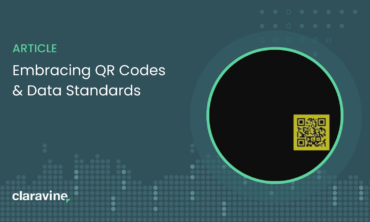Going Deep on Deep Linking: Mobile, Deferred, Tips, & Examples
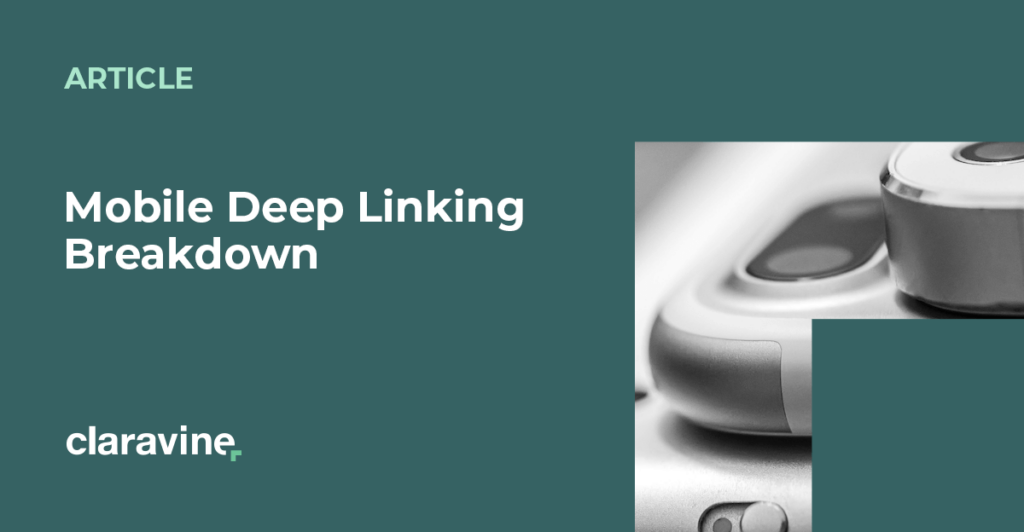
Americans are on their smartphones an average of 5.4 hours every day.
Well, no wonder.
We use them to browse, shop, consume news, conduct research, scroll through social media, play games, stream our favorite shows, movies, and music — not to mention all the personal and professional business we conduct with them.
And we spend 88% of that time within apps.
There are thousands of apps available for download, and many of them overlap. That’s why creating exceptional experiences that attract and retain users is so important.
Now there are all sorts of ways for brands to accomplish that. But we’re going to focus on how deep linking can impact the user experience (UX) and fulfill many other marketing objectives.
We’ll explain what deep linking is, the different types of deep links, and the mechanisms for creating them yourself. Then we’ll review the benefits of deep linking and share information about a few popular deep linking solution providers.
So let’s dive in.
What is a Deep Link?
In the simplest terms, a deep link is a specific URL that routes to a particular resource, whether that’s within a website or an app.
For example:
https://www.claravine.com/ = not a deep link, just a link to Claravine’s home page
https://www.claravine.com/platform/ = a deep link directing the user to a Claravine product page
https://www.claravine.com/2021/09/09/the-big-reset-re-thinking-marketing-data-strategy/ = another deep link directing the user to a post on Claravine’s blog
These are links related to a website. We’re going to explore deep linking as it relates to mobile apps.
The terms deep links and mobile deep links are often used interchangeably — we’ll do that too after making the distinction.
What is a Mobile Deep Link?
Now mobile is a different animal.
Mobile apps are essentially walled gardens that have limited ability to communicate with websites or each other. Unlike the web, users can’t just browse freely through interconnected pages.
To achieve similar functionality, app engineers must incorporate mobile deep links. Instead of simply launching the app’s home page, these links contain information that directs a user to an app or the relevant content within it.
Think of it as a link to a specific “page” within a mobile app, even though it’s not really a page, per se.
When you receive an order confirmation email from an e-commerce marketplace with a link to “track your order,” you’re clicking on a mobile deep link that will launch the app right to the order tracking screen.
What Are Deferred Deep Links?
Now mobile links only work when the user has the app installed on their mobile device.
But there’s a fallback for users who don’t have your app: deferred deep links.
Source: Branch
For those users, the link is deferred until they download and open the app.
You’ve seen this play out before on your device. You click on a link within one of the mobile sites you use daily — let’s say it’s an article about top fast-casual restaurants on The Washington Post’s site. There’s a 2-for-1 ad for Chipotle’s new smoked brisket burrito, and of course, you click on it. But since you don’t have the Chipotle app installed, you get a prompt to download it to claim the offer.
You proceed, and you’re taken to the app’s page on the App Store or Play Store. After completing the download, you click on “open.” That’s when the deferred deep link kicks in and takes you to the ad content within the newly downloaded app.
Incorporating deferred deep links are essential when you’re running ads targeting new customers. Getting them to download your app is your first objective so it’s critical you make it easy to do. Without a deep link, a potential customer must follow these steps:
- Open a separate tab for the app or play store.
- Search for your app.
- Download it.
- Open your app.
Then they must navigate to the ad content themselves or return to the ad on the mobile site where they started and click on it again.
Providing a multi-step, friction-filled process like this to claim an offer, you’re sure to lose scores of potential customers.
What Are Contextual Deep Links?
Developers can give users a more personalized experience during the onboarding process — when a user first downloads an app — through contextual deep links.
They function like mobile deep links and deferred deep links, directing users to a specific resource within an app or the store for download. But contextual links also store information about the user, such as their name, who referred them, what channel they came from, and which promotion code they want to claim with their order.
You can leverage this data to direct users to a welcome screen or prompt a specific promo code for a segment of users. The information is also valuable to marketers tasked with measuring the performance of inbound marketing activities.
Deep Linking Mechanisms
While web URLs are standardized and independent of the browser or OS you’re using, mobile doesn’t have an industry standard. So app developers must create separate deep links for iOS and Android. Here are the mechanisms they use.
- URI schemes: This traditional deep linking method involves creating custom deep links using a URI scheme (i.e., facebook://). Adding a path to a specific page within the app makes a deep link (i.e., facebook://claravine).
This method has its drawbacks. There’s no built-in fallback solution if the user doesn’t have the app installed — they’ll see an error page unless the developer creates a redirect. There’s also no way to prevent other apps from claiming the same URI scheme.
- Apple Universal links (iOS): Apple stopped supporting URI schemes for deep linking and created its own standard instead. Universal Links provide a single link that will open your app immediately — if it’s installed on the device — without opening the browser or loading the URL. If the app is not present, the link can launch the browser and direct the user to the corresponding content on your mobile site. You can also configure Universal Links to support deferred deep linking.
- Android App Links (Android): Google developed App Links in response to Apple’s Universal Links, though it still supports URI schemes. App Links are very similar from a functionality standpoint — they will launch your app if it’s installed or direct a user to your mobile website. And they can also be configured to support deferred deep linking.
6 Benefits of Deep Linking
If users have to manually navigate through your app to find the content they’re looking for, you can count on losing potential conversions.
But deep linking isn’t just about providing a more streamlined user experience. Instead, it’s about driving certain behaviors to meet your business goals and giving your marketers insight into their customer acquisition strategies.
Let’s get more specific about how deep linking is beneficial.
1. Drives engagement
Deep links allow you to keep users engaged, directing them immediately to the relevant resource that sparked their interest in the first place. Without them, they’d have to navigate to the information themselves, and many could lose interest in the process.
2. Improves campaign performance
By recording the specific content and channels that drive the most engagement, deep links give marketers the insight they need to measure campaign performance and optimize future campaigns.
3. Optimizes conversions
Mobile users make twice as many purchases in-app than on the mobile web. And that’s due to deep links’ ability to drive users directly to the point of the sale.
4. Pinpoints attribution
Deep links allow you to identify the source and acquisition cost of your conversions so you can make informed decisions about your future marketing campaigns.
5. Supports retargeting efforts
Retargeting campaigns are more effective when you incorporate deep linking. When a lapsed user clicks on a deep link, they can be brought back to the product page they viewed or the shopping cart they abandoned, which will increase the chances of reengagement.
6. Boosts retention rates
Users expect apps to be reliable, fast, and secure. They also expect a personalized experience. Contextual deep links allow you to provide a customized experience that users will be twice as likely to come back to.
Top Deep Linking Solution Providers
Implementing deep linking can be a complex, time-consuming, painful process. And once they’re set up, links can break for all sorts of reasons. So they need to be continuously monitored, updated, and reconfigured.
Thankfully, you don’t have to build and maintain deep links yourself. Instead, you can use a deep linking solution provider and reap all the additional features they offer.
Here are a few popular platforms that offer deep linking.
Kochava
Brands like yelp, Microsoft, McDonald’s, and Dunkin’ use Kochava to support all phases of their marketing strategy, including attraction, engagement, analysis, and optimization.
Here are the offerings within Kochava’s Marketers Operating System (m/OS):
- Free App Analytics: Robust, free solution offering a consolidated view of your app’s performance data with tools for attribution, deep linking, user consent, and measurement
- Kochava Collective: Audience targeting and segmentation, premium data feeds to get to know your customers better, and enrichment of your first-party data
Get more information about Kochava’s products and pricing.
Branch

Brands like Grubhub, The Knot, reddit, and TikTok, rely on Branch’s linking and attribution platform to optimize their user experience and measure results across different devices, platforms, and marketing channels.
Here are the key features of Branch’s solution:
- Triggered Banners: Drive mobile web visitors with an immediate and seamless path into your app
- Universal Ads: Achieve the highest level of accuracy for attribution across channels
- Universal Email: Bridge your email-to-app gap and power down-funnel conversion
- Over the Top (OTT) Support: Get insight into the performance of historically difficult-to-measure OTT ad campaigns
- QR Code support: Leverage QR codes to engage and convert users who discover your brand offline
- SKAdNetwork: Protect your users’ privacy and combat ad fraud while gathering accurate, high-level advertising metrics to assist your marketers
Get more information about Branch’s attribution and deep linking solutions, and pricing.
AppsFlyer

Brands like ebay, Visa, and Nike leverage AppsFlyer’s attribution platform for privacy-preserving measurement, analytics, engagement, and fraud protection.
Here are a few of AppsFlyer’s solutions:
- Marketing analytics: Gain a 360-degree view of attribution and performance data to inform future marketing decisions
- Incrementality solution: Prove the actual value of your marketing campaigns through cross-platform incremental lift testing
- SK360 for SKAdNetwork coverage: Break past the limitations of the SKAdNetwork with a comprehensive solution to support and measure your iOS campaigns
- Xpend for cost aggregation: Get the accurate and holistic insight you need to understand your true mobile ROI
- OneLink deep linking engine: Create exceptional user experiences that convert across marketing channels and operating systems
Get more information about AppsFlyer’s solutions and pricing.
Branch vs. AppsFlyer
Both platforms have their share of rabid fans and industry accolades. And each claims several competitive advantages over the other.
If you’re evaluating both, determine whether these features and capabilities are unique and then decide how important they are to your business.
Branch
Branch gets a bit granular with their competitive advantages.
- Anonymous, predictive algorithm that leverages historical attributions to ensure high accuracy attribution
- Lightweight, open-source SDKs that provide insight into the code you’re adding to your app and allow for passing contextual data through installs
- Single, non-split dashboard view of iOS and Android platforms
- Support for customized link URLs to match your brand
- Links are designed to drive conversions — not just measure them
AppsFlyer
AppsFlyer positions these high-level competitive advantages.
- G2’s mobile attribution leader in Spring 2021, representing 65% of the global market share
- Responsible for creating a new industry standard for privacy and security with the highest data compliance standards
- 24/7 support available with a live rep
- Unmatched scale and uptime support with the most accurate data in the industry
The Importance of Ensuring Data Integrity When Implementing Deep Linking
Both Branch and AppsFlyer are integrated into Claravine for bulk management of standardized data. Claravine’s Data Standards Cloud serves as a data integrity gatekeeper, so the marketing operations team puts good data in and gets good data out.
Without data integrity, deep links will devolve into a mess of mismatched taxonomies that won’t allow different teams in different regions to understand a campaign’s data or performance.
Data governance for marketing professionals allows the team to set up a standard data and metadata classification system. This way, every piece of data collected aligns and is stored similarly in the data warehouse.
With matching data, MarkOps teams can analyze campaigns apples-to-apples and uncover more meaningful insights than if they had to take a distinct approach to analyze every set of data from every team.
5 Best Practices for Deep Linking
Our world is becoming increasingly mobile. Last year, global in-app spending was nearly $111 billion. It’s expected to reach $340 billion by 2027.
To stay competitive, brands must provide an exceptional mobile experience to attract and retain users. Deep linking enables an essential component — an integrated, seamless, and personalized experience for your app users.
These best practices will ensure the most effective deep linking strategy.
- Keep track of your deep links. Like any link, deep links are breakable. Be sure to monitor and periodically test your deep links, manually or with automation tools. Tracking is also pertinent to performance reporting and optimization.
- Offer incentives. Mobile deep links with incentives behind them — discounts, exclusivity, limited-time deals — will compel new users to download and launch your app. Plus, they encourage sharing, broadening the reach of your links.
- Deploy mobile-UX prompts. Remind a user that their experience will be improved if they switch from their browser to your app. When they click a mobile deep link within a browser banner, they can easily download the app for better UX.
- Add them to your emails. Chances are you’re sharing links in your email newsletters and alerts. So, instead of sharing the link to your latest blog on your website, offer a mobile deep link that brings the user to an in-app blog experience. Do the same for profile, security, payment, preferences, and other essential experiences.
- Get social. Mobile deep links within social content can bring app-savvy users to your own app, and even make it easier to share your app’s content back to their social feeds. Then, whenever someone clicks their shared content, that user will be prompted to download your app, too.
4 Deep Linking Examples
From a user perspective, deep links provide a smooth and seamless UX. But for ecommerce brands, deep links direct potential customers to the best place in the app as fast as possible to drive maximum conversions. Here are common ways brands implement deep linking.
Social Media
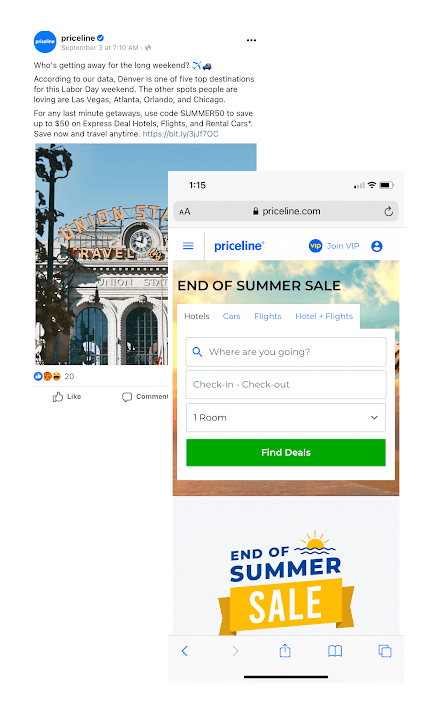 Placing a link within a paid ad on Facebook, Twitter, Instagram, Google, Snapchat, etc., is one of the most common use cases for deep links. This can be helpful as you sell on Instagram or try to link to a product from Facebook.
Placing a link within a paid ad on Facebook, Twitter, Instagram, Google, Snapchat, etc., is one of the most common use cases for deep links. This can be helpful as you sell on Instagram or try to link to a product from Facebook.
Priceline added a deep link into a Facebook ad for an end-of-summer sale. In this case, clicking on the link brought the user directly to a page on Priceline’s mobile website where they could search for destinations that were part of the sale.
SMS (Text Messaging)
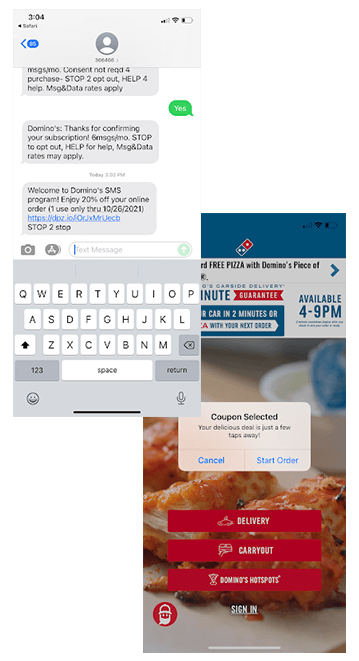
Implementing deep links within text messages is an effective way to reengage or reward customers to drive more purchases.
Domino’s sent a user who agreed to receive text messages a special offer to place an online order. The message included a deep link that opened the Domino’s app installed on the user’s device. By directing the user to the ordering page and applying the 20% off coupon automatically, Domino’s delivers a quick and seamless UX without risking losing the user to a competitor.
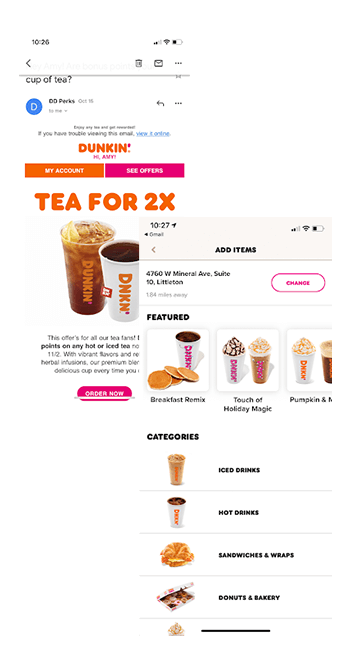
Email marketing is an important marketing channel, one that 66% of businesses rely on for building their brand and communicating with customers. It’s another fantastic medium to leverage deep links.
Dunkin’ sent an email message detailing a special offer. It included a deep link that brought the user to the ordering page on the already installed mobile app.
Web-to-App Banner
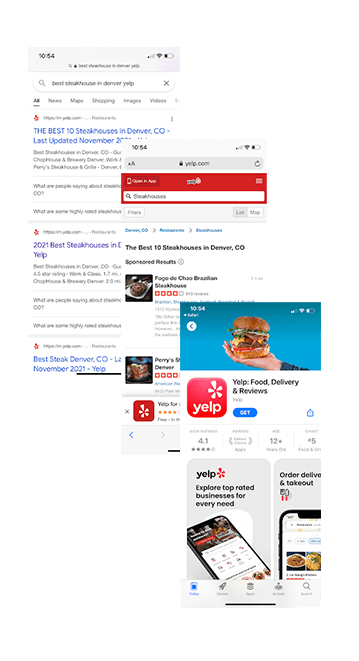
Mobile apps are faster, more efficient, more secure, and provide a better overall UX than their mobile website counterparts. Brands utilize deep linking to encourage users to download their app so they can provide that enhanced experience — plus push notifications for special offers, loyalty rewards, etc.
A user with a craving for a good steak did a Google search and clicked on a link to yelp’s mobile website. A web-to-app banner encourages the user to download the yelp app where they’ll discover better functionality (like the ability to read reviews).
More on Deep Linking
- Claravine + Branch Integration – Mobile Deep Link Optimization
- Google Campaign URL Builder Limitations and Alternatives



